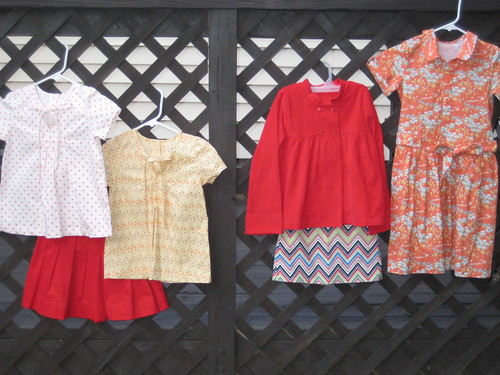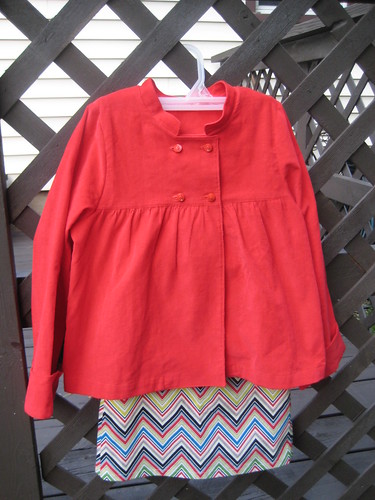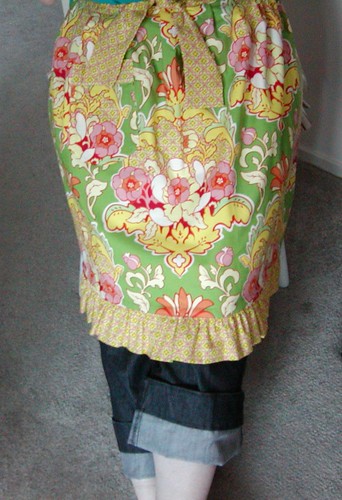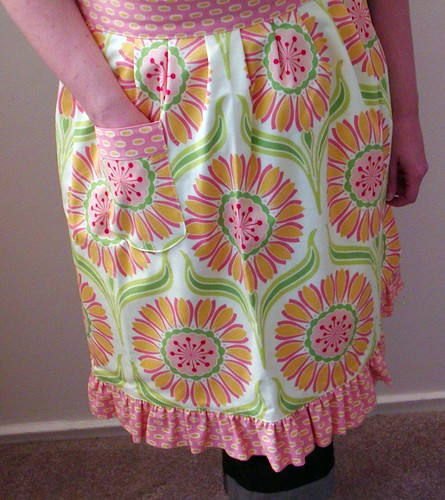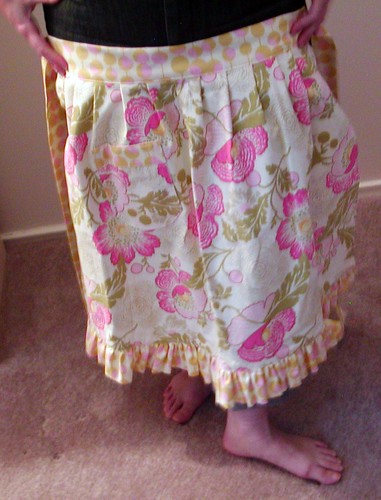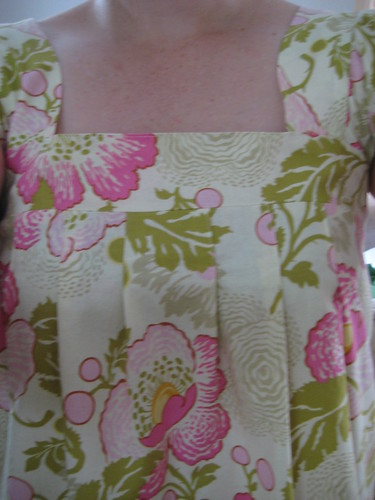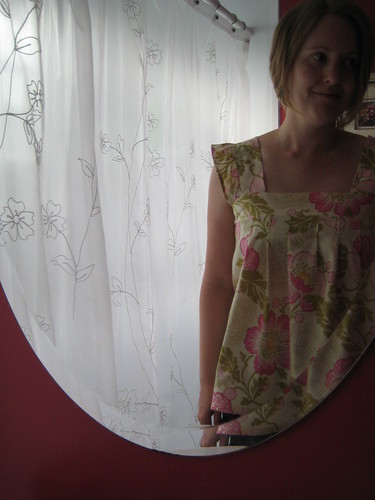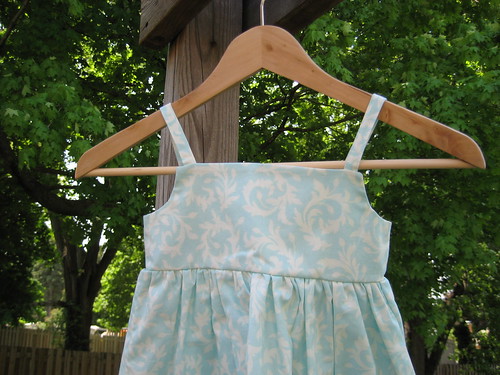Showing posts with label adventures in sewing. Show all posts
Showing posts with label adventures in sewing. Show all posts
September 16, 2010
Kindergarten!
For more than a year now Little Miss Lou has been talking about when she was little. Because you know that at 4 going on 5 you are all grown up and ready to take on the world. Or really just take on kindergarten. And that’s just what she started doing last week. As a complete, rambling aside….How did this happen? It was but yesterday that I met her for the first time. She was tiny little thing, only slightly bigger than a five pound bag of flour. Her car seat seemed to consume her and her beautiful, pink baby flesh. And poof, overnight, she’s five and getting ready for her first day of school. I certainly don’t feel five years older but one look at her and I realize time has been marching along. And in that gap of time a beautiful kid emerged, full of energy, imagination, politeness, and the occasional bad joke. So, what was I to do but make her a kindergarten wardrobe? I may not be able to stop those hands of time but I can certainly turn out a handmade wardrobe special enough to mark this amazing milestone. Of course, the patterns are from Oliver + S. They are simple, classic silhouettes and they’ve never let me down. I picked the jump rope dress (because I not so secretly wish they had an adult size), the Sunday brunch jacket and skirt, and the 2 + 2 blouse and skirt. For fabrics I wanted a palette of red, orange, turquoise, and blue. That led me to prints from Joel Dewberry, Heather Bailey, Cosmo Cricket, and Anna Griffin. And because not everything can be a print I chose some red broadcloth and red fine wale corduroy that feels as soft as velvet. I couldn’t be more proud of the wardrobe I came up with. It’s perfect for a girl her age and will take her from late summer through fall and early winter. Imagine the dress on chilly days with tights and a cardigan. Or those blouses with a cute pair of cords and a long sleeve T underneath. And then there is the brunch jacket with a dark pair of jeans, some wild socks, and a pair of brown mary janes. But all that pales in comparison to how proud I am of Little Miss Lou. Though she was a bit nervous she handled herself with such confidence that first day. Congratulations, my sweet Lou! I hope you enjoy every day of this new adventure.
October 19, 2009
Let There Be Ruffles
Being a bit of a planner and organizer I like to get my Christmas shopping and making done early. However, my colleague put me to shame in this regard when, in May, she requested that I make some aprons for her to give as Christmas gifts. That’s right…more than seven months in advance.
A week later I showed her piles of beautiful fabrics. She chose some of my favorites from Heather Bailey and Amy Butler, prints she thought would perfectly suit her mom and sisters. The style she requested was a half apron with a ruffley hem, cute pocket, and ties long enough to come around to the front. No problem!
I suffered with a mental sewing block before finally getting around to putting these together though. I think I feared the ruffley hem. But then I found my sewing mojo and the gathering foot I bought more than a year ago. Yep, I’d completely forgotten about it. I wish I hadn’t.
What you can do with that foot is amazing. You start with two perfectly flat, boring fabrics and in a minute or two you are left with one gathered piece of fabric attached to a flat piece of fabric. From now on everything shall be ruffled!
A week later I showed her piles of beautiful fabrics. She chose some of my favorites from Heather Bailey and Amy Butler, prints she thought would perfectly suit her mom and sisters. The style she requested was a half apron with a ruffley hem, cute pocket, and ties long enough to come around to the front. No problem!
I suffered with a mental sewing block before finally getting around to putting these together though. I think I feared the ruffley hem. But then I found my sewing mojo and the gathering foot I bought more than a year ago. Yep, I’d completely forgotten about it. I wish I hadn’t.
What you can do with that foot is amazing. You start with two perfectly flat, boring fabrics and in a minute or two you are left with one gathered piece of fabric attached to a flat piece of fabric. From now on everything shall be ruffled!
August 13, 2009
Made by Me/Made by Rae
When it comes to sewing there are only a few things that I hate. One of those things I hate is clothing construction for moi. I know zip about fit and pattern alteration, and these seem to be important parts of clothing construction. So far this summer I’ve failed miserably at a dress (shapeless shift!) and turning said shapeless shift into a skirt. I hold out hope I can rescue the skirt but for now we need a little time apart. But if at first, and second, you don’t succeed try, try again. And try again I did with this fabulous spring ruffle top from Made by Rae. The beauty of this pattern is that there are no pattern pieces. You measure where you need to measure and construct your own perfectly fitted pattern piece. Genius! And the construction was so easy, so straight-forward, that I completed it in an afternoon. It’s not my typical blouse. I tend to shy away from really loose, flowing tops, always afraid someone might mistake me for a pregnant woman. But, I have successfully worn this out in public on several occasions and not once was I asked my due date or berated for drinking a beer in my condition. And, it’s a good thing, too. I probably would have popped them in the nose. Hoping, of course, not to get any blood on my beautiful summer top.
June 16, 2009
Weekend Sewing, my first experience
I was totally enamored with this book the first time I flipped through it at Borders. It is filled with lovely styling and photography; it does its job of selling the simple summer weekend. There are flowing, easy to wear dresses, picnics, running though a field of flowers, and paddling around a lake. I bought it: hook, line, and sinker.
Then I tried my first pattern, the flower girl dress, and realized that beauty really is only skin deep. Now settle in with a cup of something soothing because this is a long one. I encountered my first mistake in the introduction. It claims to fit little girls between the ages of 4 and 8. Little Miss Lou is your average sized 4 year old and even the largest size was too small for her by one inch. OK, not a big deal. I just enlarged the pattern on a copier so that it was half her chest measurement plus additional for the seam allowances called for in the pattern. Heather acknowledges this error on her web page and suggests adding additional width to the largest pattern size, but not additional height. This doesn’t seem quite right to me. If you need addition width, don’t you also need additional height to maintain the same proportion?
Moving on to the fabric requirements and cutting diagram. Like Elise, I found these to be a bit off. The pattern doesn’t indicate the width of fabric required just a length of one yard. If you’re using a typical 44/45” wide quilting weight cotton there is no way to place the pattern pieces on a yard of fabric so that the lengthwise grain runs the length of the garment. And that was using the largest pattern pieces provided in the book, not my enlarged pieces. So I channeled Tim Gunn and made it work by cutting a contrasting band of white to add to the bottom of the dress skirt. If you cut these bands at double the length you need you can iron them in half, attach to the skirt bottom and avoid needing to hem the garment. Now let’s talk about those step-by-step instructions. I’ve made a lot of garments for kids that have a bodice and never have I seen such strange instructions for putting together a bodice. I read through it a few times, trying to make sense of what she was talking about in the words and diagrams. In the end I gave up and did it my way. Well, it wasn’t really my way but Amy Butler and Leisl Gibson’s way. I suggest you go that route as well because it’s easy, peasy. All you need to do is attach the front/back of the bodice lining at the sides seams. Repeat for the bodice exterior. Now pin your lining and exterior pieces right sides together along the top edge of the bodice.
Where to put the straps you ask? Good question. It’s not marked on the pattern so I made a guess. I sandwiched one end of each strap between the exterior and lining piece on one side of the bodice. I then stitched a seam around the top of the bodice. I clipped into the seams around the curved bits and turned the bodice right side out.
At this point I was pretty annoyed with the instructions so I didn’t even bother trying to follow the rest of the pattern as written. Instead I just went with what I knew from Amy and Leisl. I attached the contrasting bands to the bottom of my skirt panels and then attached the front and back panels, finishing the seams. (I used the serger-like stitch that is on my Bernina though a zig-zag will also work.) At this point I marked the centers of my bodice and centers of my skirt (again no marking provided on the pattern). At the top of the skirt I sewed in two rows of basting stitches less than ½ inch from the top. Then I gathered the skirt until it was the same width as the bodice. With right sides together, I matched up the markings on the bodice and skirt and attached with a ½ inch seam. I finished the edges like above.
At this point I needed to fit the dress on the girl to figure out how long those straps really needed to be and where to place a buttonhole. (One of the errata indicates that it’s impossible to get the dress on and off without either snaps or buttons.) You can use whatever method is your favorite for making buttonholes and sewing on buttons. I chose to hide mine. The straps button on the inside of the back bodice.
Are you still reading? I hope so. I wanted to give as much detail as I could on how I made sense of the construction of this dress. Because this is such a lovely book to pick up and look through I’m sure it’s drawing in lots of people who are new to sewing. Without any previous sewing experience though I worry that poorly written instructions and diagrams will turn off those new sewers forever. And I just can’t let that happen. Sewing is just too rewarding an experience. I’m hoping that the editors of this book are taking the reviews to heart and are busily working on the second edition. I understand that mistakes happen but I cannot imagine how so many errors made it through the entire book process. It’s sad and disappointing.
Then I tried my first pattern, the flower girl dress, and realized that beauty really is only skin deep. Now settle in with a cup of something soothing because this is a long one. I encountered my first mistake in the introduction. It claims to fit little girls between the ages of 4 and 8. Little Miss Lou is your average sized 4 year old and even the largest size was too small for her by one inch. OK, not a big deal. I just enlarged the pattern on a copier so that it was half her chest measurement plus additional for the seam allowances called for in the pattern. Heather acknowledges this error on her web page and suggests adding additional width to the largest pattern size, but not additional height. This doesn’t seem quite right to me. If you need addition width, don’t you also need additional height to maintain the same proportion?
Moving on to the fabric requirements and cutting diagram. Like Elise, I found these to be a bit off. The pattern doesn’t indicate the width of fabric required just a length of one yard. If you’re using a typical 44/45” wide quilting weight cotton there is no way to place the pattern pieces on a yard of fabric so that the lengthwise grain runs the length of the garment. And that was using the largest pattern pieces provided in the book, not my enlarged pieces. So I channeled Tim Gunn and made it work by cutting a contrasting band of white to add to the bottom of the dress skirt. If you cut these bands at double the length you need you can iron them in half, attach to the skirt bottom and avoid needing to hem the garment. Now let’s talk about those step-by-step instructions. I’ve made a lot of garments for kids that have a bodice and never have I seen such strange instructions for putting together a bodice. I read through it a few times, trying to make sense of what she was talking about in the words and diagrams. In the end I gave up and did it my way. Well, it wasn’t really my way but Amy Butler and Leisl Gibson’s way. I suggest you go that route as well because it’s easy, peasy. All you need to do is attach the front/back of the bodice lining at the sides seams. Repeat for the bodice exterior. Now pin your lining and exterior pieces right sides together along the top edge of the bodice.
Where to put the straps you ask? Good question. It’s not marked on the pattern so I made a guess. I sandwiched one end of each strap between the exterior and lining piece on one side of the bodice. I then stitched a seam around the top of the bodice. I clipped into the seams around the curved bits and turned the bodice right side out.
At this point I was pretty annoyed with the instructions so I didn’t even bother trying to follow the rest of the pattern as written. Instead I just went with what I knew from Amy and Leisl. I attached the contrasting bands to the bottom of my skirt panels and then attached the front and back panels, finishing the seams. (I used the serger-like stitch that is on my Bernina though a zig-zag will also work.) At this point I marked the centers of my bodice and centers of my skirt (again no marking provided on the pattern). At the top of the skirt I sewed in two rows of basting stitches less than ½ inch from the top. Then I gathered the skirt until it was the same width as the bodice. With right sides together, I matched up the markings on the bodice and skirt and attached with a ½ inch seam. I finished the edges like above.
At this point I needed to fit the dress on the girl to figure out how long those straps really needed to be and where to place a buttonhole. (One of the errata indicates that it’s impossible to get the dress on and off without either snaps or buttons.) You can use whatever method is your favorite for making buttonholes and sewing on buttons. I chose to hide mine. The straps button on the inside of the back bodice.
Are you still reading? I hope so. I wanted to give as much detail as I could on how I made sense of the construction of this dress. Because this is such a lovely book to pick up and look through I’m sure it’s drawing in lots of people who are new to sewing. Without any previous sewing experience though I worry that poorly written instructions and diagrams will turn off those new sewers forever. And I just can’t let that happen. Sewing is just too rewarding an experience. I’m hoping that the editors of this book are taking the reviews to heart and are busily working on the second edition. I understand that mistakes happen but I cannot imagine how so many errors made it through the entire book process. It’s sad and disappointing.
June 14, 2009
Not the skirt I planned to make

I had planned to make a yard-sale wrap skirt from Weekend Sewing. It looked like a simple project, so even if the notoriously bad directions led me astray I figured I had a good chance of making it work. The pattern call for 2.5 yards of 45" fabric and I had 3 of this summery Midwest Modern print on hand. Perfect, or so I thought. After I traced the pattern I noticed that there was no diagram for how to lay out the pattern pieces on 45" fabric. Strange, but I could deal with that. Until I realized that, in fact, it is impossible to cut out enough panels for the larger sized skirt from 2.5 yards of fabric. Or 3 yards. I estimated that I would need 8-9 yards of 45" fabric to cut out 9 panels; more if the print was directional (like those made by the author herself). No wonder there was no diagram for cutting out panels from 45" fabric; it can't be done.
Surely this error was due to some mishap as the book passed from author to editor to pattern testers and it would be fully explained on the errata page. Alas, no such clarification was forthcoming. Strangely, upon googling peer reviews of this book, I found only glowing praises, many citing the "excellent and clear directions". In my opinion, I don't think anyone test-sewed the yard-sale skirt pattern before the book went to press. I understand that mistakes happen, but please correct them, acknowledge their extent, explain what happened. Can you tell I'm a little disappointed?
Enough about the lemons, let's move on to lemonade. Or, in this case, a Barcelona skirt. I love this pattern, it having been a staple of my summer wardrobe last year. Since I used a lighter cotton than for the previous two, I lined this one with a lovely pima cotton that I found at my local fabric store. I was pleasantly surprised that lining it only added about half an hour on to the construction time. Fortunately the rain let up yesterday and I was able to get outside to take some photos. And experiment with my remote control and tripod. I even attempted some action shots: I love bloggers who are able to convey movement in their photos.
Yes, we're pretty happy to see the sun around these here parts.
Subscribe to:
Posts (Atom)

